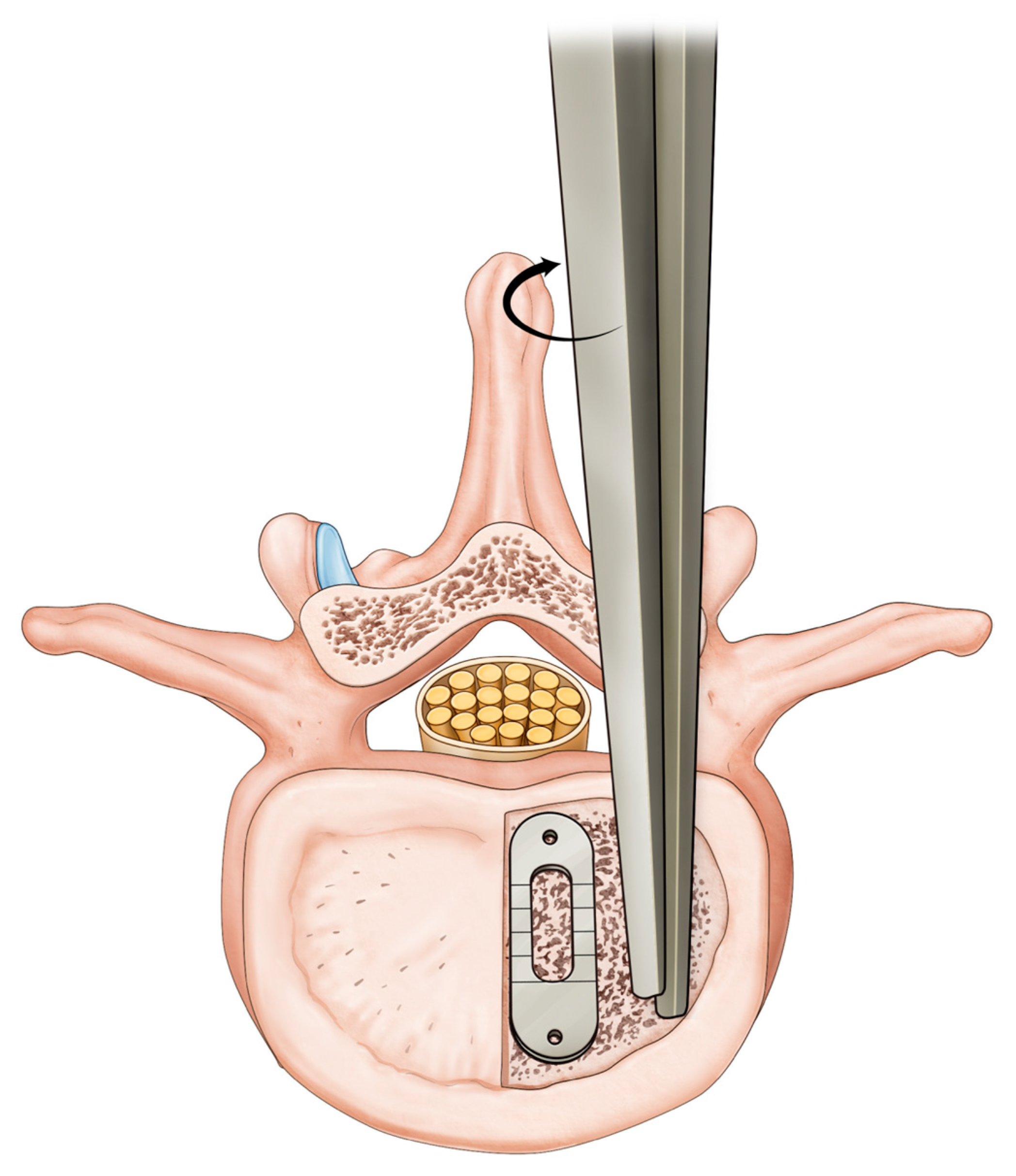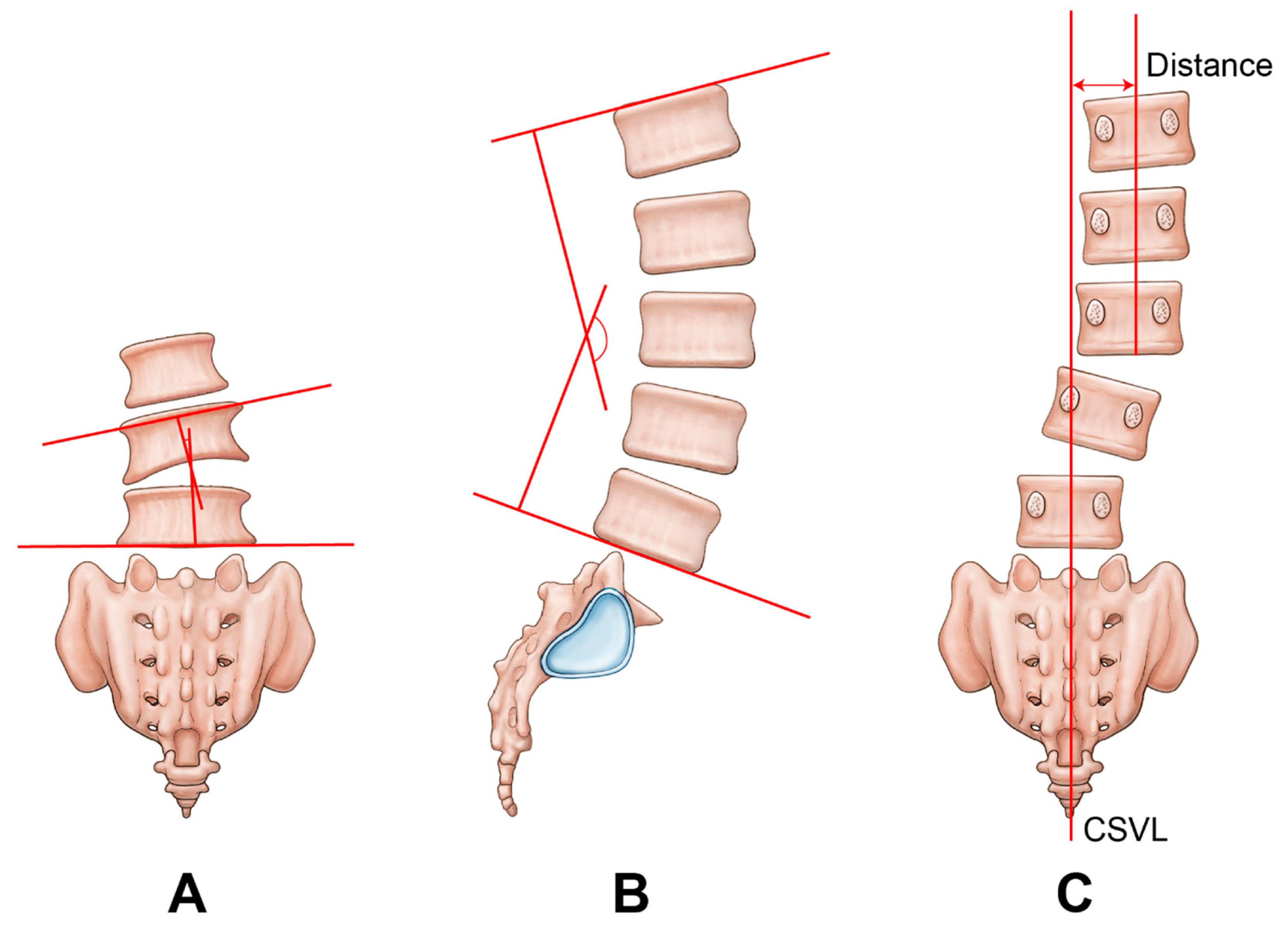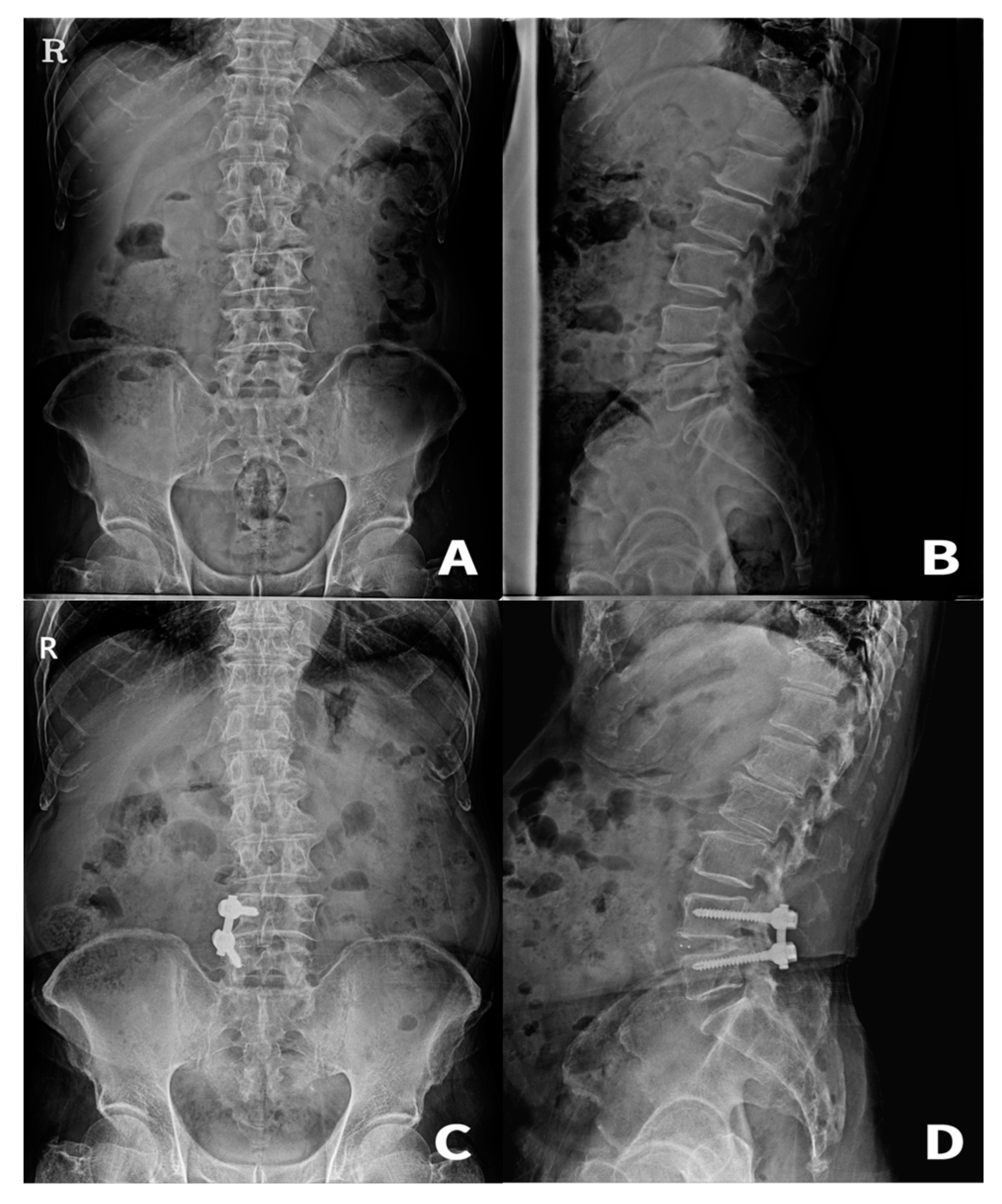Submitted:
22 September 2023
Posted:
26 September 2023
You are already at the latest version
Abstract
Keywords:
1. Introduction
2. Materials and Methods
2.1. Patients
2.2. Surgical procedures
2.3. Data Collection and Outcome Assessment
2.4. Statistical Analysis
3. Results
3.1. Patients and Characteristics
3.2. Comparison of Characteristics and Perioperative Information between Two Groups
3.3. Comparison of Clinical and Radiological Outcomes between Two Groups
3.4. Intra- and Inter-Observer Reliabilities
4. Discussion
5. Conclusions
Author Contributions
Funding
Institutional Review Board Statement
Informed Consent Statement
Data Availability Statement
Conflicts of Interest
References
- Lee, N.; Kim, K.N.; Yi, S.; Ha, Y.; Shin, D.A.; Yoon, D.H.; Kim, K.S. Comparison of outcomes of anterior, posterior, and transforaminal lumbar interbody fusion surgery at a single lumbar level with degenerative spinal disease. World Neurosurg. 2017, 101, 216–226. [Google Scholar] [CrossRef]
- Lan, T.; Hu, S.-Y.; Zhang, Y.-T.; Zheng, Y.-C.; Zhang, R.; Shen, Z.; Yang, X.-J. Comparison between posterior lumbar interbody fusion and transforaminal lumbar interbody fusion for the treatment of lumbar degenerative diseases: a systematic review and meta-analysis. World Neurosurg. 2018, 112, 86–93. [Google Scholar] [CrossRef] [PubMed]
- Lenz, M.; Mohamud, K.; Bredow, J.; Oikonomidis, S.; Eysel, P.; Scheyerer, M.J. Comparison of different approaches in lumbosacral spinal fusion surgery: a systematic review and meta-analysis. Asian Spine J. 2022, 16, 141–149. [Google Scholar] [CrossRef] [PubMed]
- Harms, J.G.; Jeszenszky, D. The unilateral transforaminal approach for posterior lumbar interbody fusion. Orthop. Traumatol. 1998, 6, 88–99. [Google Scholar]
- Xue, H.; Tu, Y.; Cai, M. Comparison of unilateral versus bilateral instrumented transforaminal lumbar interbody fusion in degenerative lumbar diseases. Spine J. 2012, 12, 209–215. [Google Scholar] [CrossRef]
- de Kunder, S.L.; van Kuijk, S.M.; Rijkers, K.; Caelers, I.J.; van Hemert, W.L.; de Bie, R.A.; van Santbrink, H. Transforaminal lumbar interbody fusion (TLIF) versus posterior lumbar interbody fusion (PLIF) in lumbar spondylolisthesis: a systematic review and meta-analysis. Spine J. 2017, 17, 1712–1721. [Google Scholar] [CrossRef]
- Patel, J.Y.; Kundnani, V.G.; Chawada, B. Is older age a contraindication for single-level transforaminal lumbar interbody fusion? Asian Spine J. 2021, 15, 447–454. [Google Scholar] [CrossRef]
- Yang, E.-Z.; Xu, J.-G.; Liu, X.-K.; Jin, G.-Y.; Xiao, W.; Zeng, B.-F.; Lian, X.-F. An RCT study comparing the clinical and radiological outcomes with the use of PLIF or TLIF after instrumented reduction in adult isthmic spondylolisthesis. Eur. Spine J. 2016, 25, 1587–1594. [Google Scholar] [CrossRef]
- Wang, L.; Wang, Y.; Li, Z.; Yu, B.; Li, Y. Unilateral versus bilateral pedicle screw fixation of minimally invasive transforaminal lumbar interbody fusion (MIS-TLIF): a meta-analysis of randomized controlled trials. BMC Surg. 2014, 14, 87. [Google Scholar] [CrossRef]
- Gologorsky, Y.; Skovrlj, B.; Steinberger, J.; Moore, M.; Arginteanu, M.; Moore, F.; Steinberger, A. Increased incidence of pseudarthrosis after unilateral instrumented transforaminal lumbar interbody fusion in patients with lumbar spondylosis. J. Neurosurg. Spine 2014, 21, 601–607. [Google Scholar] [CrossRef]
- Choi, U.Y.; Park, J.Y.; Kim, K.H.; Kuh, S.U.; Chin, D.K.; Kim, K.S.; Cho, Y.E. Unilateral versus bilateral percutaneous pedicle screw fixation in minimally invasive transforaminal lumbar interbody fusion. Neurosurg. Focus 2013, 35, E11. [Google Scholar] [CrossRef] [PubMed]
- Song, X.; Ren, D.; Wu, D.; Zhang, F.; Han, S.; Wang, J. Transforaminal lumbar interbody fusion with reduction of slippage of vertebrae for isthmic lumbar spondylolisthesis: Unilateral versus bilateral interbody fusion. Clin. Neurol. Neurosurg. 2021, 203, 106588. [Google Scholar] [CrossRef] [PubMed]
- Liu, J.; Deng, H.; Long, X.; Chen, X.; Xu, R.; Liu, Z. A comparative study of perioperative complications between transforaminal versus posterior lumbar interbody fusion in degenerative lumbar spondylolisthesis. Eur. Spine J. 2016, 25, 1575–1580. [Google Scholar] [CrossRef] [PubMed]
- Aoki, Y.; Yamagata, M.; Ikeda, Y.; Nakajima, F.; Ohtori, S.; Nakagawa, K.; Nakajima, A.; Toyone, T.; Orita, S.; Takahashi, K. A prospective randomized controlled study comparing transforaminal lumbar interbody fusion techniques for degenerative spondylolisthesis: unilateral pedicle screw and 1 cage versus bilateral pedicle screws and 2 cages. J. Neurosurg. Spine 2012, 17, 153–159. [Google Scholar] [CrossRef] [PubMed]
- Kirkaldy-Willis, W.H.; Paine, K.W.; Cauchoix, J.; Mclvor, G. Lumbar spinal stenosis. Clin. Orthop. Relat. Res. 1974, 99, 30–50. [Google Scholar] [CrossRef]
- Hwang, S.H.; Park, S.-W.; Kim, Y.-B. Risk factors for symptomatic contralateral foraminal stenosis after unilateral transforaminal lumbar interbody fusion. World Neurosurg. 2020, 133, e452–e458. [Google Scholar] [CrossRef] [PubMed]
- Takahashi, T.; Hanakita, J.; Watanabe, M.; Kawaoka, T.; Takebe, N.; Kitahara, T. Lumbar alignment and clinical outcome after single level asymmetrical transforaminal lumbar interbody fusion for degenerative spondylolisthesis with local coronal imbalance. Neurol. Med. Chir. (Tokyo) 2014, 54, 691–697. [Google Scholar] [CrossRef]
- Wang, J.; Zhou, Y.; Zhang, Z.F.; Li, C.Q.; Zheng, W.J.; Liu, J. Comparison of one-level minimally invasive and open transforaminal lumbar interbody fusion in degenerative and isthmic spondylolisthesis grades 1 and 2. Eur. Spine J. 2010, 19, 1780–1784. [Google Scholar] [CrossRef]
- Cheh, G.; Bridwell, K.H.; Lenke, L.G.; Buchowski, J.M.; Daubs, M.D.; Kim, Y.; Baldus, C. Adjacent segment disease followinglumbar/thoracolumbar fusion with pedicle screw instrumentation: a minimum 5-year follow-up. Spine 2007, 32, 2253–2257. [Google Scholar] [CrossRef]
- Weiner, D.K.; Distell, B.; Studenski, S.; Martinez, S.; Lomasney, L.; Bongiorni, D. Does radiographic osteoarthritis correlate with flexibility of the lumbar spine? J. Am. Geriatr. Soc. 1994, 42, 257–263. [Google Scholar] [CrossRef]
- Liang, Y.; Shi, W.; Jiang, C.; Chen, Z.; Liu, F.; Feng, Z.; Jiang, X. Clinical outcomes and sagittal alignment of single-level unilateral instrumented transforaminal lumbar interbody fusion with a 4 to 5-year follow-up. Eur. Spine J. 2015, 24, 2560–2566. [Google Scholar] [CrossRef]
- Kai, Z.; Wei, S.; Chang-qing, Z.; Hua, L.; Wei, D.; You-zhuan, X.; Xiao-jiang, S.; Jie, Z. Unilateral versus bilateral instrumented transforaminal lumbar interbody fusion in two-level degenerative lumbar disorders: a prospective randomised study. Int. Orthop. 2014, 38, 111–116. [Google Scholar] [CrossRef]
- Chen, H.-H.; Cheung, H.-H.; Wang, W.-K.; Li, A.; Li, K.-C. Biomechanical analysis of unilateral fixation with interbody cages. Spine 2005, 30, E92–E96. [Google Scholar] [CrossRef] [PubMed]
- Ambati, D.V.; Wright Jr, E.K.; Lehman Jr, R.A.; Kang, D.G.; Wagner, S.C.; Dmitriev, A.E. Bilateral pedicle screw fixation provides superior biomechanical stability in transforaminal lumbar interbody fusion: a finite element study. Spine J. 2015, 15, 1812–1822. [Google Scholar] [CrossRef] [PubMed]
- McAfee, P.C.; Farey, I.D.; Sutterlin, C.E.; Gurr, K.R.; Warden, K.E.; Cunningham, B.W. 1989 Volvo Award in basic science. Device-related osteoporosis with spinal instrumentation. Spine 1989, 14, 919–926. [Google Scholar] [CrossRef] [PubMed]
- Goel, V.K.; Lim, T.H.; Gwon, J.; Chen, J.Y.; Winterbottom, J.M.; Park, J.B.; Weinstein, J.N.; Ahn, J.Y. Effects of rigidity of an internal fixation device. A comprehensive biomechanical investigation. Spine 1991, 16, S155–161. [Google Scholar] [CrossRef]
- Kim, K.-T.; Lee, S.-H.; Lee, Y.-H.; Bae, S.-C.; Suk, K.-S. Clinical outcomes of 3 fusion methods through the posterior approach in the lumbar spine. Spine 2006, 31, 1351–1357. [Google Scholar] [CrossRef]




| Score | |
| Intermittent claudication | |
| Normal | 3 |
| Able to walk > 500m but with pain, tingling, and/or muscle weakness | 2 |
| Able to walk > 500m because of pain, tingling, and/or muscle weakness | 1 |
| Able to walk > 100m because of pain, tingling, and/or muscle weakness | 0 |
| Kirkaldy-Willis criteria | |
| The patient has returned to his normal work and other activities with little or no complaint | Excellent |
| The patient has returned to his normal work but may have some restriction in other activities and may on occasion after heavy work have recurrent back pain requiring rest a few days | Good |
| The patient has to reduce his working capacity, take a lighter job or work part-time, and occasionally have a recurrence of pain requiring absence from work for 1-2 weeks, once or twice a year | Fair |
| The patient does not return to work | Poor |
| UITLIF (n = 63) |
BITLIF (n = 111) |
p-value | |
|---|---|---|---|
| Age (yrs) | 68 (62, 71) | 61 (55, 68) | < 0.001*,† |
| Sex, n (%) | 0.145‡ | ||
| Female | 36 (57.1) | 77 (69.4) | |
| Male | 27 (42.9) | 34 (30.6) | |
| BMD, T-score | -2.66 (-3.41, -1.83) | -2.56 (-3.17, -1.59) | 0.259† |
| Fused segment, n (%) | 0.859§ | ||
| L2-3 | 1 (1.6) | 2 (1.8) | |
| L3-4 | 6 (9.5) | 8 (7.2) | |
| L4-5 | 40 (63.5) | 77 (69.4) | |
| L5-S1 | 16 (25.4) | 24 (21.6) | |
| Diagnosis, n (%) | 0.012*,‡ | ||
| Spinal stenosis | 37 (58.7) | 46 (41.4) | |
| Degenerative spondylolisthesis | 23 (36.5) | 43 (38.7) | |
| Spondylolytic spondylolisthesis | 3 (4.8) | 22 (19.8) | |
| Operation time (min) | 185.0 (170.0, 210.0) | 225.0 (200.0, 265.0) | < 0.001*,† |
| EBL (ml) | 300.0 (250.0, 500.0) | 550.0 (400.0, 800.0) | < 0.001*,† |
| Follow-up (months) | 82.0 (66.0,98.0) | 85.0 (72.0,85.0) | 0.252† |
| UITLIF (n = 63) |
BITLIF (n = 111) |
p-value | |
|---|---|---|---|
| Radiologic outcomes | |||
| LCA (°) | |||
| Preoperative | 2.09 (5.53, 5.53) | 1.38 (0.63, 3.87) | 0.125† |
| Postoperative | 1.03 (1.70, 1.70) | 0.97 (0.60, 1.86) | 0.344† |
| Last follow-up | 1.74 (3.34, 3.34) | 1.27 (0.64, 2.37) | 0.201† |
| Interval change | 0.73 (1.48, 1.48) | 0.73 (0.39, 1.37) | 0.687† |
| LA (°) | |||
| Preoperative, mean ± SD | 38.98 ± 12.88 | 42.41 ± 14.16 | 0.114‡ |
| Postoperative, mean ± SD | 41.67 ± 10.28 | 43.91 ± 10.79 | 0.183‡ |
| Last follow-up, mean ± SD | 38.48 ± 12.82 | 42.25 ± 13.6 | 0.075‡ |
| Interval change | 4.01 (6.97, 6.97) | 3.93 (1.71, 7.74) | 0.701† |
| COB (mm) | |||
| Preoperative | 5.98 (10.9, 10.9) | 5.47 (2.96, 9.20) | 0.823† |
| Postoperative | 3.80 (6.97, 6.97) | 4.72 (1.84, 8.10) | 0.234† |
| Last follow-up | 4.02 (8.04, 8.04) | 4.94 (2.20, 8.81) | 0.195† |
| Interval change | 3.86 (6.52, 6.52) | 4.54 (2.01, 6.86) | 0.367† |
| Clinical outcomes | |||
| Intermittent claudication scores | |||
| Preoperative | 1 (0, 1) | 1 (0,1) | 0.039*,† |
| 1 year postoperative | 2 (2, 2) | 2 (2, 2) | 0.495† |
| K-W criteria 1 year postoperative, n (%) | 0.707§ | ||
| Excellent/Good | 49 (77.8) | 89 (80.2) | |
| Fair/Poor | 14 (22.2) | 22 (19.8) |
| Effect | Num DF | Den DF | F value | p-value |
|---|---|---|---|---|
| Operation type | 1 | 172 | 3.37 | 0.068 |
| Time | 1 | 172 | 514.7 | < 0.001* |
| Operation type*Time | 1 | 172 | 2.18 | 0.1415 |
| Variable | Effect | Num DF | Den DF | F value | p-value |
|---|---|---|---|---|---|
| LCA | Operation type | 1 | 157 | 0.187 | 0.666 |
| Preoperative LCA | 1 | 157 | 1.089 | 0.298 | |
| Postoperative LCA | 1 | 157 | 2.124 | 0.147 | |
| Sex | 1 | 157 | 0.661 | 0.417 | |
| Age | 1 | 157 | 0.021 | 0.884 | |
| Surgeon | 4 | 157 | 1.293 | 0.275 | |
| Fused segment | 3 | 157 | 1.434 | 0.235 | |
| Subsidence | 1 | 157 | 0.027 | 0.870 | |
| Diagnosis | 2 | 157 | 0.478 | 0.621 | |
| BMD | 1 | 157 | 0.000 | 0.988 | |
| COB | Operation type | 1 | 157 | 0.958 | 0.329 |
| Preoperative COB | 1 | 157 | <0.001 | 0.992 | |
| Postoperative COB | 1 | 157 | 18.586 | < 0.001* | |
| Sex | 1 | 157 | 0.002 | 0.966 | |
| Age | 3 | 157 | 1.897 | 0.170 | |
| Surgeon | 4 | 157 | 0.143 | 0.966 | |
| Fused segment | 3 | 157 | 0.950 | 0.418 | |
| Subsidence | 1 | 157 | 2.972 | 0.087 | |
| Diagnosis | 2 | 157 | 0.133 | 0.875 | |
| BMD | 1 | 157 | 1.461 | 0.229 | |
| LA | Operation type | 1 | 157 | 0.339 | 0.561 |
| Preoperative LA | 1 | 157 | 3.965 | 0.048* | |
| Postoperative LA | 1 | 157 | 0.983 | 0.323 | |
| Sex | 1 | 157 | 0.958 | 0.329 | |
| Age | 1 | 157 | 0.027 | 0.870 | |
| Surgeon | 4 | 157 | 0.857 | 0.491 | |
| Fused segment | 3 | 157 | 0.666 | 0.574 | |
| Subsidence | 1 | 157 | 1.690 | 0.196 | |
| Diagnosis | 2 | 157 | 1.108 | 0.333 | |
| BMD | 1 | 157 | 0.793 | 0.375 |
| UITLIF (n = 63) |
BITLIF (n = 111) |
p-value | |
|---|---|---|---|
| Cage subsidence, n (%) | 8 (12.7) | 8 (7.2) | 0.351 * |
| Pseudarthrosis, n (%) | 3 (4.8) | 2 (1.8) | 0.354 † |
| Metal failure, n (%) | 2 (3.2) | 4 (3.6) | 1.000 † |
| ASD, n (%) | 34 (54.0) | 58 (52.3) | 0.952 * |
| Postoperative infection, n (%) | 2 (3.2) | 5 (4.5) | 1.000 † |
Disclaimer/Publisher’s Note: The statements, opinions and data contained in all publications are solely those of the individual author(s) and contributor(s) and not of MDPI and/or the editor(s). MDPI and/or the editor(s) disclaim responsibility for any injury to people or property resulting from any ideas, methods, instructions or products referred to in the content. |
© 2023 by the authors. Licensee MDPI, Basel, Switzerland. This article is an open access article distributed under the terms and conditions of the Creative Commons Attribution (CC BY) license (http://creativecommons.org/licenses/by/4.0/).





